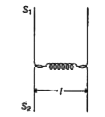Derive an expression for mutual inductance of two long coaxial solenoids of each having length l, area of cross-section A.
Consider two long solenoids S1andS2 of same length l, such that solenoid S2 surrounds solenoid S1 completely.

Let n1 be the number of turns per unit length of S1,n2 be the number of turns per unit lenght of S2,I1 be current passed through solenoid S1andϕ21 be flux linked with S2 due to current flowing through S1.
ϕ21∝I1orϕ21=M21I1
where, M21 is the coefficient of mutual induction of the two solenoids. When current is passed through solenoid S1, an emf is induced in solenoid S2. Magnetic field produced inside solenoid (S1) on passing current through it.
B1=μ0n1I1
Magnetic flux linked with each turn of solenoid (S2) will be equal to B1 times the area of cross-section of solenoid S1.
Magnetic flux linked with each turn off the solenoid S2=B1A.
Therefore, total magnetic flux linked with the solenoid S2 is given by
ϕ21=B1A×n2l=μ0n1I1×A×n2l
ϕ21=μ0n1n2AI1l
Substituting the value of ϕ21 from above, we get
M21=μ0n1bn2Al ...(i)
Similarly, the mutual inductance between the two solenoids, when current is passed through solenoid S2 and induced emf is produced in solenoid S1 and is given by
M12=μ0n1n2Al
M12=M21=M (say)
Hence, coefficient of mutual induction between the two long solenoids,
M=μ0n1n2Al
We can rewrite Eq. (i) as
M=μ0(N1l)(N2l)πr12×l
M=μ0N1N2Al=μ0n1n2Al=μ0n1n2πr21l
Thus, the mutual inductance of two coils is the property of their combination. It does not matter, which one of them functions as the primary or the secondary coil. This fact is also know as reciprocity theorem.
Similar Questions
Define mutual inductance between a pair of coils. Derive expression for the mutual inductance of two long coaxial solenoids of same length wound one over the other.
View SolutionDeduce an expression for the mutual inductance of two long coaxial solenoids but having different radii and different number of turns.
Or
Obtain the expression for the mutual inductance of two long coaxial solenoids S1 and S2 wound one over the other, each of length I and radii r1andr2, and number of turns per unit length n1andn2 respeetively, when a current I is set up in the outer solenoid S2.View SolutionDefine the term 'mutual inductance between the two coils. Obtain the expression for mutual inductance of a pair of long coaxial solenoids each of length l and radii r1andr2(r2>r1). Total number of turns in two solenoids are N1andN2 respectively.
View SolutionDefine self-inductance. Write its SI unit. Derive an expression for self-inductance of a long, aircored solenoid of length l, cross-sectional area A (radius r), and having N number of turns.
View Solution(a) Define self inductance. Write its S.I. units
(b) Derive and expression for self inductance of a long solenoid of length l cross-sectional area A having N number of turns.View SolutionFind the mutual inductance of two long concentric solenoids for a length l. The area of cross-section of inner solenoid is A and number of turns per unit length are n1 and n2.
 View Solution
View SolutionFind the mutual inductance of two long concentric solenoids for a length I. The area of cross-section of inner solenoid is A and number of turns per unit length are n1 and n2.
View SolutionThe self inductance of a solenoid of length L, area of cross-section A and having N turns is-
View SolutionThe self inductance of a solenoid of length L, area of cross-section A and having N turns is-
View SolutionDerive the expression for the self inductance of a long solenoid of cross sectional area A and length l, having n turns per unit length.
View Solution

